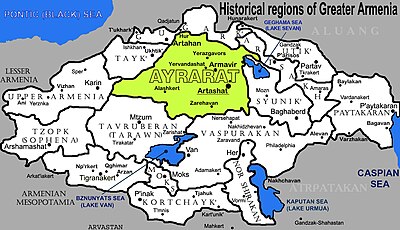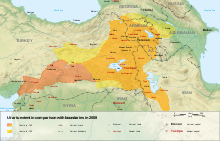| Part of a series on the |
|---|
| History of Armenia |
 |
| Prehistory |
| Antiquity |
| Middle Ages |
| Early modern age |
| Modern age |
| Timeline • Origins • Etymology |
Etiuni (other names Etiuḫi, Etiu, Etio) was the name of an early Iron Age tribal confederation in northern parts of Araxes River, roughly corresponding to the subsequent Ayrarat Province of the Kingdom of Armenia. Etiuni was frequently mentioned in the records of Urartian kings, who led numerous campaigns into Etiuni territory. It is very likely it was the "Etuna" or "Etina" which contributed to the fall of Urartu, according to Assyrian texts. Some scholars believe it had an Armenian-speaking population.
Names and etymology

Igor Diakonov wrote that Etiuni was a Urartian name meaning "land/people of Etio", whereas Mirjo Salvini preferred to read it as "Etiu". Ethnographer Armen Petrosyan suggested that this name could be a Urartian cuneiform rendering of Hatio (sometimes transliterated as Hattiyo or Hatiyo), which Diakonov had offered as a reconstructed initial form of the modern Armenian endonym, Hay (հայ).
The cuneiform writing system the Urartians used lacked a symbol to designate an "h" sound, so the Urartians used either a symbol usually meant to convey a laryngeal h (ḫ, χ), or opted to not use any symbol to try to convey this sound. Petrosyan, citing Diakonoff and Gevorg Jahukyan, said that Urartian "e" may correspond with Armenian "a" when used at the start of words.
Petrosyan, citing 19th-century linguists Friedrich Spiegel and Heinrich Kiepert, proposed that "Hatio" might ultimately derive from Proto-Indo-European *poti, meaning "lord, master, husband." According to this theory, the name, with plural suffix, developed from *potiio→*hetiyo→*hatiyo→hay.
Further information: Name of ArmeniaThe Urartians sometimes used the variation, Etiuḫi, which seems to have referred to the people of Etiuni specifically.
Location and regions

Etiuni was composed of a number of small kingdoms and tribes, included Iga (also known as Igani, Iya, and Aia), on the south shore of Lake Cildir, Abiliani and Apuni, probably corresponding to the Armenian Abełean and Havnunik, in Kars region, and the Luša, Katarza, Uiṭeruḫi (Witeruḫi), and Gulutaḫi, of the Ararat plain. Another region of Etiuni was Liquini, located near Armavir. Petrosyan suggested that Erkuaḫi, another Etiunian region located on the north side of Mount Ararat, could be a native Armenian name for the two peaks of the mountain (compare to Armenian erku երկու 'two').
The city of Aza, mentioned by Rusa as an important temple-city along the Araxes River, has been connected to the wealthy religious center, Azara, which was later placed by Strabo near Artashat.
The Etiunian lands of Uelikuni (Welikuni) and Tiluḫu were located on the western shore of Lake Sevan and Kekuni was on the lake's northern shore. The archaeological site of Lchashen, probably corresponding to the city of Ishtikuni, was located in one of these kingdoms.
The Urartians mentioned "the four kings of Uduri-Etiuni." This may have referred to a separate, but perhaps culturally and linguistically connected, confederation from Etiuni, comprising the lands Lueḫi, Kemani, Urteḫini, and Arquqini, stretching along the southern shore of Lake Sevan. The word "Uduri" probably means "water" (referring to its location along Lake Sevan).
Etiuni seems to have been bordered by Diaeuḫi to the west, Urartu and possibly the separate lands of Biani to the south and Kulḫi to the north or northwest.
Relation with Urartu
During the co-regency of Ishpuini and his son, Menua, Urartu began expanding northward into Etiunian territories, battling the Katarza and Luša tribes, bragging about conquering Liquini and "the mighty land of" Erkuaḫi, and putting Etiuni under tribute as a result.
Menua's son, Argishti, ventured further into Etiunian territory than his predecessors, building the fortress of Erebuni (located in Yerevan) on newly conquered land, and bringing to it 6600 warriors from Hatti and Shupria. Argišti conquered Apuni, Luša (castrating its king as a result), and Iga, taking many of the inhabitants of these regions as captives.
However, the Etiunians seem to have revolted and invaded Urartu during Argishti's reign, stealing the aštiuzi (perhaps an idol of a god; compare this word to Armenian astuats 'god') of the Urartian religious center, Musasir.
Sarduri II, Argishti's son, also launched numerous military campaigns in Etiuni in the 740s BCE, battling with local rulers and the king of Etiuni, Diaṣuni. However, whatever became of this confrontation with Diaṣuni is unknown, as the text breaks off.
According to the Assyrians, "the Etinaeans" revolted three times during the reign of Rusa I, Sarduri II's son. These revolts apparently resulted in Urartian military losses and Urartu being "plundered."
A later Assyrian text mention that Urartu had been "destroyed" by the "people of Etuna."
Ethno-linguistic makeup
Igor Diakonov considered it possible that the Etiuni were a Hurro-Urartian people, although he did not explain his reasoning for this classification.
More recently, Armen Petrosyan, linguist Hrach Martirosyan, and other scholars have suggested Armenian etymologies for a number of Etiunian personal, place, tribal, and religious names. Armenian names and words have been identified in Urartu as well, suggesting the possibility that Armenian speaking tribes could have constituted part of the populations of both lands.
In addition to Armenian speaking populations, there were also likely Scythian and/or Cimmerian tribes present in Etiuni or its vicinity. The names of the Etiunian land Ishkugul (probably near Gyumri) and its prince, Saga-tur or Sagaputara (perhaps the Skayordi of Moses of Khorene) are suggestive of the presence of Scythians and/or Cimmerians.
Rulers
The Urartians only named one king of Etiuni, Diaṣuni of Iga (or Iya). Petrosyan etymologized Diaṣuni as being an otherwise unattested Armenian name meaning "born of god" (տիւ + ծնուն), comparing it to Greek Diogenes (Διογένης), Thracian Diazenus, Celtic Divogenos, and Sanskrit Devaja (देवजा).
Other kings of regions of Etiuni were likely rulers of smaller kingdoms or local chieftains. These included: Murinu of Uelikuni, Murini of Abiliani, Ṣinalbi of Lueḫi, Rashu of Ruishia, and Kapurini of Iga (Iya).
In historiography
Petrosyan theorized that memories of Etiuni may have been passed down by the medieval Armenian historian Movses Khorenatsi.
In the History of Armenia, Khoren says the historically unattested Armenian king, Zarmayr, led an army of "Ethiopians" to aid Troy during the Trojan War. Petrosyan speculated that Khoren or his contemporaries may have confused "Etio" for "Ethiopia" (a name they would have been more familiar with through Biblical studies).
Archaeology

Archaeologists connect Etiuni with the Lchashen-Metsamor culture. Lchashen-Metsamor culture ultimately descends from the Trialeti-Vanadzor culture.
Ishtikuni, near modern Lchashen, is a notable Etiunian archaeological site.
The Metsamor site, near modern Taronik, was an important metal-working center during the Iron Age.
See also
References
- ^ Armen Petrosyan (2007). "Towards the Origins of the Armenian People: The Problem of Identification of the Proto-Armenians: A Critical Review (in English)". Journal for the Society of Armenian Studies.
- H. W. F. Saggs. "The Nimrud Letters, 1952: Part IV." British Institute for the Study of Iraq. Iraq. Vol. 20, No. 2 (Autumn, 1958), pp. 182-212. JSTOR 4199640
- ^ Sargis Petrosyan. "Light Worship in Etiuni Lands." 2019
- ^ I. M. Diakonoff. The Pre-History of the Armenian People (revised, trans. Lori Jennings). Caravan Books, New York (1984)
- Matiossian, Vartan (2009). "Azzi-Hayasa on the Black Sea? Another Puzzle of Armenian Origins". In Hovannisian, Richard G (ed.). Armenian Pontus : the Trebizond-Black Sea communities. UCLA Armenian History and Culture Series. p. 71.
- ^ Armen Petrosyan. Էթիունին հայոց օրրան. Գիտական հոդվածների ժողովածու, նվիրված Գրիգոր Ղափանցյանի ծննդյան 130-ամյակին. Երևան 2018, էջ 299-330։. Etiuni – cradle of Armenians.
- Raffaele Biscione. "The Roots of the Urartian Kingdom. The Growth of Social Complexity on the Armenian Plateau Between and Ancient Bronze and Early Iron Ages." Over the Mountains and Far Away: Studies in Near Eastern History and Archaeology Presented to Mirjo Salvini on the Occasion of His 80th Birthday. eds. Pavel S. Avetisyan, Roberto Dan, Yervand H. Grekyan. Archaeopress. 2019.
- Raffaele Biscione et al. . "The Armenian-Italian archaeological survey in the Sevan Lake Basin, Campaigns 1994-2000." In: Raffaele Biscione, Simon Hmayakyan Neda Parmegiani (Ed.): The North-Eastern frontier Urartians and non-Urartians in the Sevan Lake basin. Rome: CNR, Istituto di studi sulle civiltà dell'Egeo e del Vicino Oriente, 2002, pp. 10-16.
- A. Mosvsisyan. "Argishti I." Institute for Armenian Studies of Yerevan State University.
- ^ R.D. Barnett. "Urartu." The Cambridge Ancient History. eds. Stanley Arthur Cook, Martin Percival Charlesworth, John Bagnell Bury, John Bernard Bury. Cambridge University Press. 1982 edition.
- Armen Petrosyan. "Indo-European *wel- in Armenian mythology." Journal of Indo-European studies. 2016, 1-2, pp. 129-146"
- ^ Hrach Martirosyan. "Origins and historical development of the Armenian language." pp. 8, 18.
- ^ Hayk Avetisyan, Pavel Avetisyan, Arsen Bobokhyan, Knarik Navasardyan, Artak Gnuni. "Notes on Urartian Era Pottery Traditions in Armenia." 2019.
- Sargis Ayvazyan. "The Haykazunis and the Kingdom of Van (Ararat-Urartu)." Fundamental Armenology. No. 2. 2015.
- Aylin U. Erdem. "The Relationship between State and Nomads in the Urartian Kingdom." Over the Mountains and Far Away: Studies in Near Eastern History and Archaeology Presented to Mirjo Salvini on the Occasion of His 80th Birthday. Archaeopress. 2019.
- Pavel Avetisyan and Arsen Bobokhyan. "Archaeology of Armenia in a Regional Context." National Academy of Sciences of Armenia, Institute of Archaeology and Ethnography. 2009. p. 18.
- Ruzan Mrtchyan. "The ancient population of Lchashen as a representative of the Bronze Age Armenian population." Moscow University Bulletin. Issue 23. 2014.
- Ali Çifçi. "Control of Capital in Urartu: Economic Resources and Movement of Commodities." Brill. 2017.
- Robert Hewsen. Armenia: A Historical Atlas. University of Chicago Press. 2001. p. 22.
- Krzysztof Jakubiak and Kinga Bigoraj. "Metsamor: the Early Iron Age/Urartian settlement in the Aras Valley, Armenia." Antiquity. 94. 2020.
| Armenia articles | ||||||||||
|---|---|---|---|---|---|---|---|---|---|---|
| History (timeline) |
|  | ||||||||
| Geography | ||||||||||
| Politics | ||||||||||
| Economy |
| |||||||||
| Culture |
| |||||||||
| Urartu topics | ||
|---|---|---|
| Language |  | |
| Kings | ||
| Cities and Fortresses | ||
| Mythology | ||